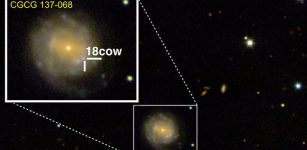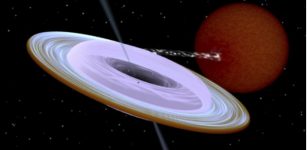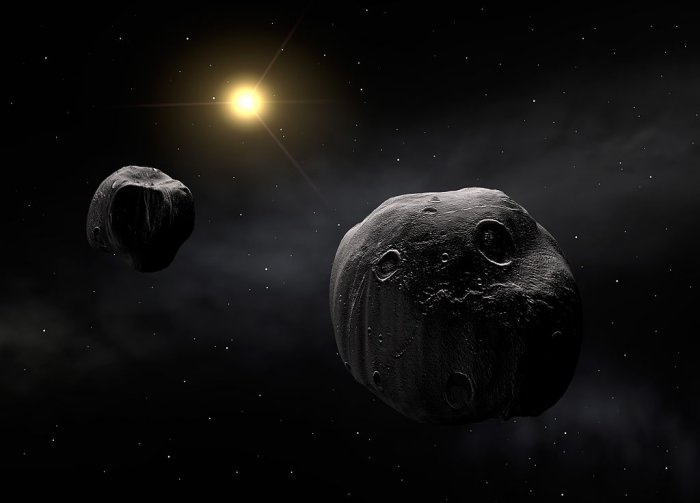Asteroids Have Days And Nights But The Yarkovsky Effect Is Dangerous
A. Sutherland – MessageToEagle.com – Just like planets and moons, asteroids orbit the Sun and they have days and nights. During its orbit around the Sun, every part of the asteroid’s surface sees sunlight, but that is not always a good thing.
Earth’s rotation period is about 24 hours, but some asteroids are faster or slower. An asteroid’s rotation rates depend on both asteroidal type and diameter and direction of rotation can differ for each individual asteroid. Asteroid 2008 HJ is very small, only 12 meters by 24 meters (39.4 feet by 78.7 feet) and it completes a rotation every 42.7 seconds. This is fastest asteroid rotation observed by astronomers.
Other asteroids take more time to complete an orbit around the Sun, usually between one hour and 80 hours.
See also:
What Is The Color Of The Sky On An Exoplanet?
Forbush Decrease: Dangerous Event That Can Affect Human Health, Technology, Earth’s Environment
Phenomenon Of True Polar Wander: What Is It?
An asteroid has an average orbital speed (how fast an object orbits the Sun) of 25 kilometers per second. However, asteroids orbiting closer to a Sun will move faster than asteroids orbiting between Mars and Jupiter and beyond. It’s also important to remember that passing by the gravitational fields of planets, such as Earth, can change the rotation or spin of asteroids.
Why Is The Yarkovsky Effect Dangerous?
Until now, there are no records of any asteroid that has hit the Sun, but it doesn’t mean it’s an impossible scenario. However, sunlight has the ability to change the course of asteroids and drastically alter the layout of the solar system. Rotating asteroids have a tough time sticking to their orbits.
When sunlight strikes a rotating asteroid, the dayside heats up; as the asteroid turns, the night side cools and releases the heat, exerting a small thrust that can change the asteroid’s direction over time.
This force, called the Yarkovsky effect, can cause rotating asteroids to drift widely over time, making it hard for scientists to predict their long-term risk to Earth.
Written by – A. Sutherland – MessageToEagle.com Senior Staff Writer
Copyright © MessageToEagle.com All rights reserved. This material may not be published, broadcast, rewritten or redistributed in whole or part without the express written permission of MessageToEagle.com
Related Posts
-
 Rare, Pulsating Star Identified 7,000 Light Years Away In Pegasus Constellation
No Comments | Feb 20, 2017
Rare, Pulsating Star Identified 7,000 Light Years Away In Pegasus Constellation
No Comments | Feb 20, 2017 -
 Hubble Telescope Discovers Dwarf Galaxy Located Only 30 Million Light-Years Away
No Comments | Feb 1, 2019
Hubble Telescope Discovers Dwarf Galaxy Located Only 30 Million Light-Years Away
No Comments | Feb 1, 2019 -
 New Dark Matter Theory Explains Two Puzzles In Astrophysics
No Comments | Dec 11, 2023
New Dark Matter Theory Explains Two Puzzles In Astrophysics
No Comments | Dec 11, 2023 -
 New Technique Reveals The Age Of Massive Southern Cross star
No Comments | Dec 8, 2021
New Technique Reveals The Age Of Massive Southern Cross star
No Comments | Dec 8, 2021 -
 ‘The Cow’ – Object Spotted 200 Million Light Years Away In Hercules Constellation – Examined
No Comments | Jan 14, 2019
‘The Cow’ – Object Spotted 200 Million Light Years Away In Hercules Constellation – Examined
No Comments | Jan 14, 2019 -
 Evidence Of Recent Volcanic Activity On Venus
No Comments | Jan 5, 2020
Evidence Of Recent Volcanic Activity On Venus
No Comments | Jan 5, 2020 -
 Distant Galaxy About 1,000 Times Brighter Than The Milky Way Discovered By Spanish Astronomers
No Comments | Jul 21, 2017
Distant Galaxy About 1,000 Times Brighter Than The Milky Way Discovered By Spanish Astronomers
No Comments | Jul 21, 2017 -
 Legend Of Baku – The Dream Eater – Was It An Ancient Supernatural Being?
No Comments | Dec 18, 2014
Legend Of Baku – The Dream Eater – Was It An Ancient Supernatural Being?
No Comments | Dec 18, 2014 -
 Death Spiral: A Black Hole Spins On Its Side
No Comments | Feb 27, 2022
Death Spiral: A Black Hole Spins On Its Side
No Comments | Feb 27, 2022 -
 Hubble Views A Tranquil Spectacular Galaxy With An Explosive Past
No Comments | Jan 17, 2022
Hubble Views A Tranquil Spectacular Galaxy With An Explosive Past
No Comments | Jan 17, 2022

